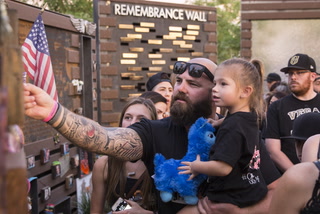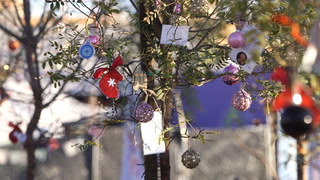Greg Zanis was the Illinois carpenter who built and erected the 58 simple white crosses in the shadow of the “Welcome to Fabulous Las Vegas” sign that turned into a focal point for a city’s grief after the Route 91 Harvest festival shooting in 2017. He died on Monday, May 4, 2020. (Las Vegas Review-Journal)
People are gathering at the Las Vegas Healing Garden for the new Remembrance Wall dedication. Words from Mayor Carolyn Goodman, Jay Pleggenkuhle, Councilman Bob Coffin, and city attorney Brad Jerbic.
Malinda Baldridge of Reno attended the Route 91 Harvest festival with her daughter, Breanna, 17, and was shot twice in the leg when the gunman fired on the crowd.
Chris Davis, father of a Route 91 Harvest festival shooting victim, Neysa Tonks, talks about a college scholarship in his daughter’s memory to assist the children of those who died in the shooting. Bizuayehu Tesfaye/Las Vegas Review-Journal @bizutesfaye
The Clark County Museum is opening an exhibit “How We Mourned: Selected Artifacts from the October 1 Memorials” of items left to honor the victims killed in the Route 91 Harvest festival shooting. (Bizuayehu Tesfaye/Las Vegas Review-Journal) @bizutesfaye
Oct. 1 mass shooting survivors Taylor Stovall and Parker Gabel meet for the first time since Gabel helped the injured Stovall to an ambulance the night of the shooting. Stovall, then 17, was shot in the arm. They met Friday at the Tropicana.
Six survivors share their lives after surviving Oct 1. Their relationships with each other have given them the tools to slowly overcome the trauma. (Rachel Aston/Las Vegas Review-Journal)
Body camera footage shows Las Vegas police in Stephen Paddock’s Mandalay Bay hotel room after breaching the door on the night of the Oct. 1 shooting.
Golden Knights raise banner honoring Oct. 1 shooting victims. On a night when the Golden Knights were looking to lock up the Pacific Division title and secure a championship banner, the team unveiled a banner of its own Saturday. The banner honors the 58 victims of the Oct. 1 Strip shooting. Knights majority owner and chairman Bill Foley and general manager George McPhee also were on the ice, along with the family of shooting victim Neysa Tonks.
Review-Journal reporters Harrison Keely and Wade Millward go over the newly released footage of Stephen Paddock before the October 1st shooting.
Review-Journal reporter Victor Joecks interviews Adam Laxalt, Attorney General and Candidate for Governor of Nevada.
Las Vegas Strip shooter Stephen Paddock had anti-anxiety medication in his system, autopsy records obtained Friday by the Review-Journal show. The autopsy report also confirms Paddock died of a self-inflicted gunshot wound to the head. Clark County Coroner John Fudenberg said in December that the 64-year-old Paddock, a high-rolling video poker player, committed suicide. He shot himself as officers closed in on his hotel room after he stopped firing at the Route 91 country music festival across the street from the Mandalay Bay. The Review-Journal reported several days after the mass shooting that a local doctor had prescribed the anti-anxiety drug diazepam, known by the brand name Valium, for Stephen Paddock back in June. After Paddock’s body was cremated, Fudenberg last month released the remains to his younger brother Eric Paddock, who lives in Orlando, Florida. Eric Paddock flew to Las Vegas to pick up the ashes after he was unable to get the coroner’s office to send him the remains. He told the Review-Journal that he does not intend to keep his brother’s ashes at his home in Orlando.
A judge on Friday ordered the Las Vegas Review-Journal and other media outlets to destroy a copy of the autopsy report of an Oct. 1 mass shooting victim, siding with the privacy concerns of the victim’s widow. The report was one of 58 that a different judge ordered the Clark County coroner’s office to release last week to the newspaper in the wake of another lawsuit, which argued that the autopsies of the Las Vegas mass shooting victims should be public. That judge also ordered the coroner’s office to release gunman Stephen Paddock’s autopsy, which has not been handed over. Friday’s ruling pertained only to the autopsy report for Charleston Hartfield, a Las Vegas police officer who was killed during the mass shooting. He was the husband of the plaintiff, Veronica Hartfield. The ruling by District Judge Richard Scotti also barred the newspaper from further reporting on Hartfield’s autopsy details. Review-Journal Editor in Chief Keith Moyer said the company would file an emergency appeal of Scotti’s decision to the Nevada Supreme Court. “These reports are important public records. Previous rulings have held that these records must be accessible to the public,” Moyer said. Scotti’s decision came after more than two hours of arguments, during which attorney Anthony Sgro argued that the widow’s privacy concerns far outweighed the public’s need to know. He also said the Review-Journal only sought the records in the first place “to sell newspapers.” The newspaper’s attorney, Maggie McLetchie, said Sgro’s comments were “strange criticism.” She argued that despite the anguish Hartfield’s widow and other victims’ families have experienced in the wake of the Oct. 1 massacre, the First Amendment still applied. After the judge’s ruling, McLetchie reiterated that the autopsy reports were partially redacted, and that the Review-Journal has no way of knowing which report was Hartfield’s. Scotti said the newspaper can either hand over all 58 autopsy reports to the coroner’s office and receive 57 back, or allow the office’s staff to come to the newsroom and select the document to destroy. “That’s a preposterous demand of a free press,” Moyer said. “This isn’t North Korea. Government officials cannot enter a newsroom and forcibly remove public records, even under a so-called court order.” Contrary to the assertion that the Review-Journal is seeking the information exclusively to sell newspapers, the editor in chief said, the Review-Journal is investigating the police and medical response to the mass shooting. “Autopsy reports are essential to uncovering potential shortcomings in the response and the Oct. 1 investigation, holding institutions accountable for those failures and ensuring authorities can take steps to make sure they aren’t repeated during future tragedies,” Moyer said. “Autopsy reports also help the public evaluate the competency of the coroner’s office, which is certainly in question.”















